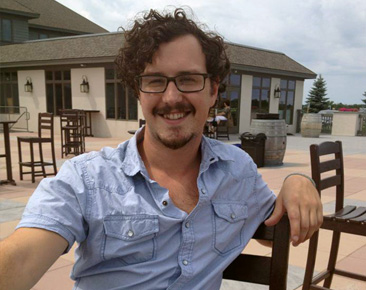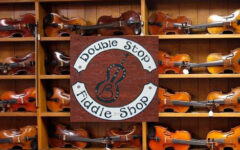
 Verse has always been an integral component of bluegrass music, just as it has for every song form. The very art of songwriting hinges on the ability to blend words and music in ways that are both attractive to the ear, and compelling to the mind. But only rarely has the attention of poets been directed to writing about bluegrass music, as opposed to writing for it.
Verse has always been an integral component of bluegrass music, just as it has for every song form. The very art of songwriting hinges on the ability to blend words and music in ways that are both attractive to the ear, and compelling to the mind. But only rarely has the attention of poets been directed to writing about bluegrass music, as opposed to writing for it.
An exception appears in the person of Russell Brakefield, who teaches writing at the University of Michigan and is also a serious bluegrass enthusiast. His experience includes teaching poetry and writing at the elementary, high school and college level, and as a managing editor for Canarium Books, who specialize in publishing poetry, sponsored by the Masters of Fine Arts program at the University of Michigan.
Russell has set about to create works of modern poetry that celebrate bluegrass, the culture from which it flows, and the people and instruments who have defined it. He shared some of these with us, a sequence of 12 short poems titled Revival, and another series of 10 he calls The High & Lonesome Sound.
This one from The High & Lonesome Sound, on the impact of Earl Scruggs’ banjo, he has graciously consented to have published here.
The High & Lonesome Sound
Earl Scruggs’ right hand fans affront that calve skin oval like a phantasm
on an onion, a shadow show, a misshapen eclipse— every sleeping soul
awakened at the run of his fingertips. Five little men bend togetheras in prayer or like a steady fleet rowing across a calm sheet of water. Let men
buy back beauty in this way, in antenna & wire, wearing down the carpet
in front of the dials. As a child, let geography mean the sudden burstof an octave harmony, a high G string drowning out the sound of shaking
herds laying down against the dying grass. Nashville, Montgomery, Jackson,
St. Louis— movement opens in the recesses of the body like an uprooted bulb,alien & dirty, shoots moving out from its center towards the cracked sky.
Let this music fill the hills with desire like the poisons of the body fill graves,
like a sweet but final embrace. At night between trains, let it replace wantwith something gentler, let it cover the tracks like blackness, seep across
the ties until even the crickets are pinned down & quiet, flush with the rocks,
intimate with movement, at odds with every aspect of resistance.
The author says that while he has had a love for bluegrass music for many years, and played it himself much of that time around Michigan and the upper Midwest, his ultimate goal is to help bring the music to a new audience.
“Part of my hope for this project is that it will intersect interests and audiences from art, literature, and music, much in the way Chris Thile and others have been bending boundaries and bringing people together around the genre. I hope that it can be a chance to unite poetry and bluegrass and elevate each.
I grew up in a home where all types of music were valued and essential. Our lives revolved around music. Every Sunday morning as children we woke up to bluegrass albums on the stereo, Bill Monroe or Vassar opening up the day. I gravitated towards this music immediately and have been enjoying it, playing it, and studying it ever since.
My true talents lie with the written word, though, and I wanted to attempt to elegize the bluegrass genre, as well as help bring the conversation of bluegrass and folk music into the literary landscape. Traditional musics have a tendency to be marginalized by academic writing circles in favor or more classical tastes, and I wanted to attempt to write something that would change that.
I also wanted to express some of the thematic cross sections between lyric poetry and the bluegrass tradition, particularly ideas of storying, social connections, and an attention to the interaction of people and their landscapes.”
Russell is currently finishing up a book of his poetry, which include all of the pieces from Revival and The High & Lonesome Sound, plus other works about the history of the genre.
“The book attempts to address ideas of music’s relationship to writing, place, and personhood and ideas about the act of telling stories and collecting oral histories. It is also interested in the sort of artistic innovation and movement that occurs within the history of different types of artistic expression, bluegrass being a primary example of the way genres and styles come into being in a collaborative way, and because of a long tradition of valuing and transferring art.”
We’ll be sure to let everyone know when this book is available. Hats off to Russell Brakefield for tackling bluegrass music in verse, and to Mark Lavengood, resonator guitarist with Lindsay Lou & The Flatbellies, for introducing us.







